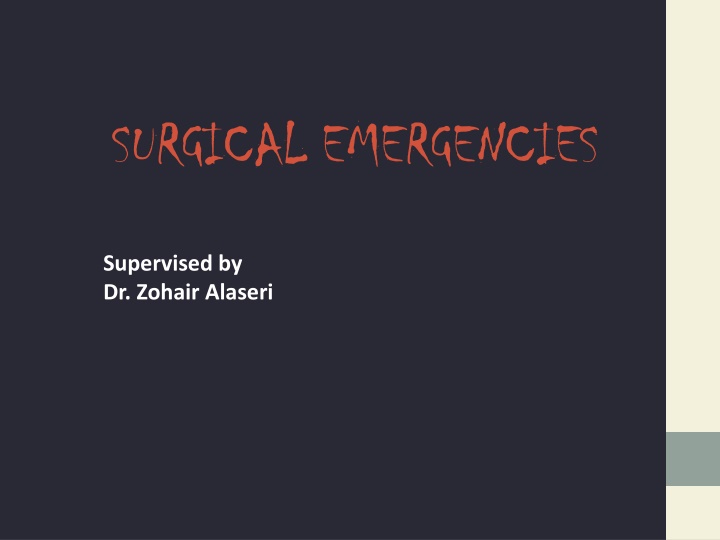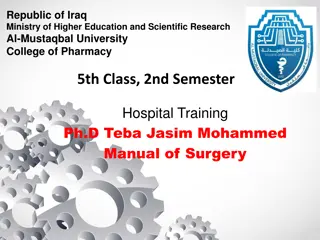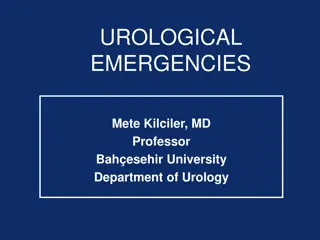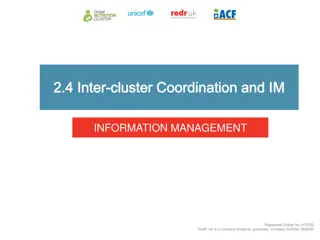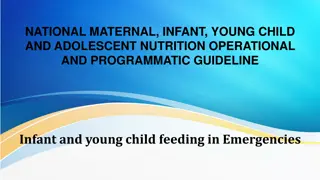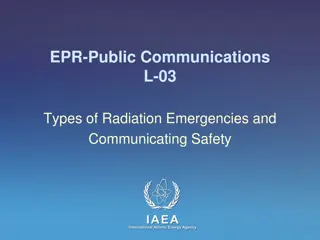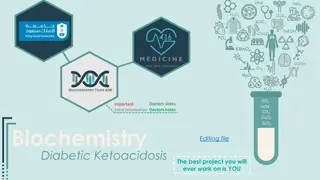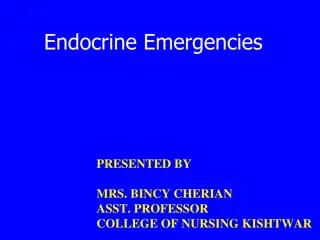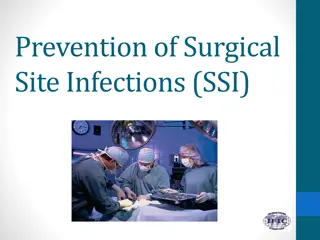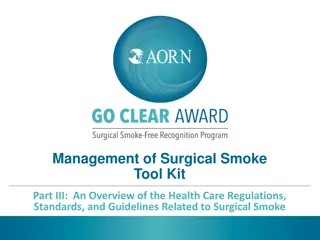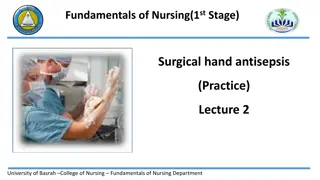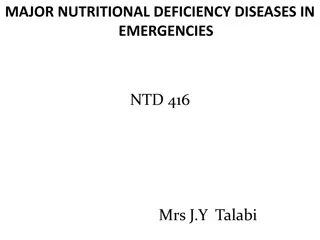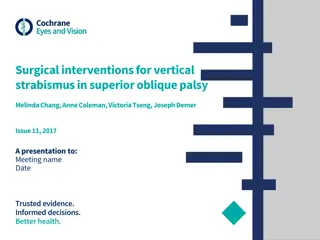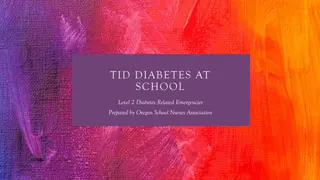Surgical Emergencies: Definition, Causes, and Presentation
Shock in surgical emergencies is a life-threatening condition requiring prompt recognition and intervention. This article covers the definition, causes (such as hypovolemic, cardiac, obstructive, and distributive shock), and key clinical presentations associated with shock. Understanding the different types of shock and their presentations is crucial for timely management in critical situations.
Download Presentation

Please find below an Image/Link to download the presentation.
The content on the website is provided AS IS for your information and personal use only. It may not be sold, licensed, or shared on other websites without obtaining consent from the author.If you encounter any issues during the download, it is possible that the publisher has removed the file from their server.
You are allowed to download the files provided on this website for personal or commercial use, subject to the condition that they are used lawfully. All files are the property of their respective owners.
The content on the website is provided AS IS for your information and personal use only. It may not be sold, licensed, or shared on other websites without obtaining consent from the author.
E N D
Presentation Transcript
SURGICAL EMERGENCIES Supervised by Dr. Zohair Alaseri
Definition Shock is equivalent to underperfusion of tissue. Medical emergency Mortality: Always greater than 20% in large studies regardless the cause
Pulmonary embolism Cardiac tamponade Pneumothorax Valvular dysfunction Acute thrombosis of prosthetic valve Critical aortic stenosis Hypovolemia Obstructive Bleeding Burns vomiting Cardiogenic Arrhythmia Ischemia rupture Cellular Poisons Hyperdynamic sepsis syndrome (early sepsis) Anaphylactic shock Central neurogenic shock Drug overdose (dihydropyridines, 1 -antagonists) Adrenal crisis Carbon monoxide Hydrogen sulfide Cyanide disturbutive
SURGICAL CAUSES OF SHOCK: (present acutely) Obstructive : PE ,pneumothorax. Hypovolemic: bleeding. Cardiac: rupture. Distributive: neurogenic shock.
NOTES The most common type of shock is hypovolemic shock. In adult most common causes of hypovolemic shock is bleeding from RTA,but in pediatric bleeding from gastroenteritis. Hypovolemia may be caused by dehydration in pediatrics and underdeveloped countries. Most common cause of cardiogenic shock is arrhythmias and ischemia. Cellular poisons: may be imp in trauma, especially if patient is still hypotensive or in shock. A common toxin with trauma is CYANIDE. SURGICAL CAUSES OF SHOCK: (present acutely) Obstructive : PE (massive, cannot be treated with thrombolytics, treated by embolectomy), pneumothorax. Hypovolemic: bleeding. Cardiac: rupture. Distributive: neurogenic shock.
Presentation Decrease in BP and malfunction of underperfused organ systems, most notably: 1. Lactic acidosis. ( marker of underperfusion ) 2. Renal (anuria/oliguria) 3. CNS dysfunstion (altered mentation) [ Hypotension Oliguria Tachycardia Altered mental status ] Common to all forms of shock
NOTES IMP. Is it important to have hypotension to diagnose shock?! NO, because a young patient may have normal BP, but is behind in fluids. A hypertensive patient may have a higher baseline. SO, u might have shock in a patient with normal BP. If patient is hypotensive then he is definitely in shock. If patient has normal BP, u must have a combination of symptoms, signs and blood tests, to give u an idea of the patients perfusion status, and help u diagnose shock. E.g capillary refilling is a very sensitive sign of shock (but not in patients with bad vascular disease)
Blood Lactate and Shock Elevated concentrations of blood lactate is a sentinel marker of widespread inadequate tissue perfusion and disappear when adequate resuscitation has been achieved. Note: why is lactate produced? In underperfusion, pyruvate converts to lactic acid. The most imp. Marker in shock is lactic acid.
General Characteristics Characterized by its effect on: 1. Cardiac output 2. Systemic vascular resistance (SVR) 3. Volume status Volume status is assessed via jugular venous pressure or pulmonary capillary wedge pressure [PCWP] Note: PCWP not recommended anymore, because it is invasive, u enter thru the subclavian artery to the right atrium to the right venticle to the pulmonary circulation.. A problem in any of these sights might give u a false reading. E.g old MI will give u PCWP.
NOTES JVP may be a good indicator of shock, but its absence doesn t mean absence of shock. Because, tension pneumothorax and cardiac tamponade have high JVP, and patients are in shock. So JVP is important to include shock but not to exclude shock.
Hemodynamic changes associated with different types of shock Shock Cardiac output SVR PCWP Cardiogenic Hypovolemic Neurogenic Septic SVR: systemic vascular resistance.
Approach 1. a. b. History and PE to determine possible cause: Fever and a possible site of infection septic shock. Trauma, GI bleeding, vomiting, or diarrhea hypovolemic shock. History of MI, angina, or heart disease cardiogenic shock If JVD is present cardiogenic shock Spinal cord injury or neurologic deficits neurogenic shock. c. d. e.
Cont. Approach 2. Initial steps: a. 2 large-bore IV, peripheral, intraosseous, central line b. Fluid bolus (500-1,000 mL NS ) given in most cases. c. Draw blood: CBC, electrolytes, renal function, PT/PTT d. ECG, CXR e. Continuous pulse oximetry f. Vasopressors (dopamine or norepinephrine) if patient remains hypotensive despite fluids. Still Dx? echocardiogram may help. g.
Treatment 1. 2. Note: central arterial line is not standard. What is best for the patient central or peripheral line in early stage of shock? Peripheral, because the 18 gauge needle is very wide and short, makes giving fluids thru it very easy. And it an easy procedure. If peripheral fails, do intraosseous, if it fails, then insert a central line. ABCs (airway, breathing and circulation.) all patients in shock Specific treatment for each type.
Hemorrhagic Shock =Hypovolemic Rapid reduction in blood volume Baroreceptor activation Increased strength of cardiac contraction Increased heart rate + Vasoconstriction increase in the diastolic BP narrow pulse pressure Hemorrhagic Shock Cardiac output Ventricular filling
Cause of hypovolemic Hemorrhage: - Trauma - GI bleeding - Retroperitoneal Nonhemorrhagic - Voluminous vomiting - Severe diarrhea - Severe dehydration - Burns - Third-space losses in bowel obstruction
Diagnosis If unclear from the vital signs and clinical picture, a central venous line maybe helpful for hemodynamic monitoring . ( CVP/PCWP, SVR, CO ) Almost always normal BP doesn t exclude shock in trauma cases. Increase in HR, and BP is still normal.
Hemorrhagic Shock Treat. Ensure adequate ventilation/oxygenation. Provide immediate control of hemorrhage, when possible (e.g., traction for long bone fractures, direct pressure). Initiate infusion of crystolloid solution (10 20 ml/kg) Note: give 2 L of NS, if doesn t work, give RL to avoid hyperchloremic metabolic acidosis, still doesn t work, give blood products. With evidence of poor organ perfusion and 30-minute anticipated delay to hemorrhage control, begin packed red blood cell (PRBC) infusion (5 10 ml/kg). With suspected central nervous system trauma or Glasgow Coma Scale score <9, immediate PRBC transfusion may be preferable as initial resuscitation fluid. O-negative blood is used in women of childbearing age and O-positive blood in all others imp.
Cont. Treatment For nonhemorrhagic (hypovolemic shock), blood is not necessary. Crystalloid solution with appropriate electrolyte replacement. Monitoring urine output is the useful indicator of the effectiveness of treatment. When there is massive bleeding we should be cautious to give vasopressor.
Obstructive Shock Acute massive pulmonary embolism (PE) right ventricular overload impairs left ventricular Circulatory Shock Note: #1 cause of PE and DVT in hospitals is orthopedic surgery. Pt always started on heparin.
Obstructive Shock Note: Rt ventricle enlarges on the expense of left ventricle, End Diastolic Volume of left ventricle will fall, and as a result COP will decrease.
Massive Pulmonary Embolism PE complicated by shock is best treated by 1. Ventilatory support Note: norepi is the best vasopressor, why? Selectively decreases pulmonary vascular resistance. Can we give other vasopressors? Yes 2. Volume infusion 3. Norepinephrine 4. Thrombolytic therapy.
Fluid therapy in Massive PE Infusion of 500 mL of dextran 40 over 20 mins Excessive fluid may be counterproductive in massive PE and has been reported to worsen hypotension. Since right ventricular pressure is already elevated, volume administration further raises pressure that compromises coronary diastolic filling and left ventricular function. Note: first line fluid is NS Over distension of the right ventricle causes a shift of the septum towards the left ventricle. This limits left ventricular filling and subsequent cardiac output. Therefore, cautious, judicious administration of fluids is recommended. Note: if u give fluids, it will decrease the resistance.
Thrombolysis vs. Surgical Therapy Very little data are available on the benefits of thrombolysis versus surgical therapy for pulmonary embolism. The largest study to date to compare these therapies examined 37 patients with massive PE and shock who were randomized to receive one of the two interventions. It showed that patients treated with thrombolytic therapy had a higher death rate, increased risk of major hemorrhage and an increased rate of PE recurrence when compared with patients treated surgically with embolectomy. However, the disadvantage of embolectomy is that it requires more hospital resources and may not always be available.
TENSION PNEUMOTHORAX It is the accumulation of air under pressure in the pleural space. this condition rapidly progresses to respiratory insufficiency, cardiovascular collapse, and, ultimately, death if unrecognized and untreated.
TENSION PNEUMOTHORAX cont. It is a clinical diagnosis: No time for investigation. Dyspnea Tachypnea Tachycardia pleuritic chest pain decrease breath sounds & hyperresonance on the affected side Tracheal deviation away JVD
Rx : Immediate decompression by needle thoracostomy in the 2nd intercostal space midclavicular line followed by tube thoracostomy in the midaxillary line in the 4th intercostal space (definitive)
CARDIAC TEMPONADE It is a bleeding into the pericardial sac resulting in constriction of heart , decrease inflow & decreased cardiac output .
Dx : Tachycardia beck s tried ( hypotension , muffled heart sound , JVD ) Kussmaul s sign ( JVP rises with inspiration )
ECG:Electrical alternans Alteration of QRS amplitude or axis
Rx : O2 , IV line fluid bolus Inotropic agent (dobutamine) pericardiocentesis. (through the fifth intercostal space, and aspirating fluid) in cardiac tamponade dx by echocardiogram in treatment surgery is mandatory
Acute splenicsequestration crisis (ASSC) Pooling of blood in the spleen characterized by rapid fall in hemoglobin concentration rise in reticulocyte count splenomegaly shock requires prompt recognition and treatment. In the adult patient, ASSC is extremely rare.
Hypotension caused by large volumes of blood (mainly sickled cells) entrapped in the spleen. Hb levels may fall acutely more than 2 g/dL less than the patient's normal value, causing circulatory compromise Prompt diagnosis and Rx with red blood cell transfusions are therefore crucial to prevent hypovolemic shock. Surgical splenectomy may be indicated in certain patients to prevent recurrences
Distributive shock Anaphylactic shock Septic shock Neurogenic shock
Anaphylactic shock Presentation: 1. Dyspnea 2. Wheeze 3. Vomiting 4. Bronchial spasm 5. Syncope & dizziness 6. Respiratory rate 25 7. SBP <90 mmHg 8. Laryngeal edema 9. Stridor 10. Cyanosis 11. flushing, and swelling of the lips 12. loss of consciousness
Anaphylactic shock Treatment: Remove antigen Airway. Have a low threshold for intubation. Breathing. 100% oxygen administration Intravascular volume expansion Epinephrine, mainstay of treatment. Steroids, IV
Anaphylactic shock Fluid Resuscitation : Volume expansion is important as part of the resuscitation with epinephrine to treat acute hypotension.Because anaphylaxis causes increase in vascular permeability, transferring intravascular fluid into the extravascular space rapidly. Initially we give, 2 to 4 L of Ringer Lactate, NS or colloid.
Causes of death in anaphylaxis Respiratory failure, 75% loss of consciousness, 12.5 % Cardiovascular system, 12.5 % THE best treatment is Anaphylactic shock IS Epinephrine IM Venom give anti venom Insect bite anaphylactic Epinephrine
Septic shock Primarily a form of distributive shock. Sepsis: infection + systemic signs of inflammation(fever, WBC, tachycardia) Severe sepsis: hypoperfusion with signs of organ dysfunction. Septic shock: the above & significant tissue hypoperfusion and systemic hypotension. Characterized by= peripheral VD, ineffective oxygen delivery and utilization.
(hypoperfusion despite normal or high COP) Macrovascularsplanchnic blood flow Microvascular Shunting Contractility PVR Distributive Obstructive Cardiogenic Septic Shock Cytotoxic Hypovolemic Capillary leak (absolute hypovolemia) Venodilation (relative hypovolemia) Cellular inability to utilize oxygen despite adequate supply
Etiology: Gram ve septecemia, most common Gram +ve septecemia, fungal, less common About 50% blood cultures are positive in pt with bacterial septic shock. Major complications: DIC, multiple organ failure and death.
Septic shock Presentation: Septic shock (surgical causes): 1.Ascending Cholangitis. 2.Perforation. 3.Bowel obstruction or ischemic. 4. Necrotizing fasciitis. 5. pancreatitis. Fever Tachycardia Tachypnea Hypotension Hypoperfusion: confusion, oliguria
Septic shock Treatment: ABC Intubate if necessary Fluid resuscitation 500 1000cc Crystalloid. Empiric antibiotics Vasopressors: norepinephrine, epinephrine, dopamine, phenylephrine Activated protein C for severe sepsis. Why? Cause in DIC it was found that it is mostly caused by deficiency of these factors. Look for site of infection, drain if possible. Send blood for CBC, lactic acid, glucose, blood culture. Hyperglycemia, leukocytosis, elevated lactic acid. acidosis
Necrotizing fasciitis A surgical cause of septic shock. A term used to label uncommon but potentially lethal infections. Types: 1- Type 1 is polymicrobial and involves non-group A streptococci plus anaerobes. 2- type 2, the pathogen is group A beta-hemolytic streptococci. Sites: Type 1: abdomen, perineum Type 2: extremities Pathophysiology: A substance in the cell wall of streptococci causes a separation of the dermal connective tissue, resulting in continued inflammation and necrosis.
